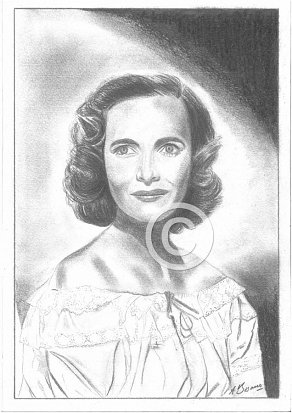Teresa Wright
Pencil Portrait by Antonio Bosano.

Shopping Basket
The quality of the prints are at a much higher level compared to the image shown on the left.
Order
A3 Pencil Print-Price £45.00-Purchase
A4 Pencil Print-Price £30.00-Purchase
*Limited edition run of 250 prints only*
All Pencil Prints are printed on the finest Bockingford Somerset Velvet 255 gsm paper.
P&P is not included in the above prices.

Recommended viewing
Shadow of a doubt (1943)
There’s an absurdity to this Hitchcock favourite that any sympathetic viewer will overlook, thanks in no small part to the central performances of Wright and Joseph Cotten.
With plausibility safely parked, it’s time to settle down and enjoy the Newton family’s quiet life in the North California town of Santa Rosa. Their eldest daughter, ‘young Charlie,’ decides that things need brightening up, and resolves to contact her Uncle Charlie (after whom she is named) and invite him to stay. On arrival at the telegraph office she discovers he is already on his way. Beside herself with excitement, she is there with her father at the station as he arrives, somewhat perplexed by his elderly gait as the porter helps him down from his carriage. As he recognises them with a heartfelt wave, he begins to walk more purposefully towards his welcoming committee, shedding years with every step. Reassured that her uncle is not ill, she remains unaware that he is being pursued by a couple of detectives who suspect him of being “The Merry Widow Murderer,” an evil strangler wanted in connection with the deaths of several rich East coast widows.
Safely ensconced in the family home, Charlie Oakley creates quite a stir and charms the ladies club, as well as the bank president where his brother-in-law works. Young Charlie however, begins to notice some odd behavior on his part, such as cutting out a story in the local paper about a man who marries and then murders rich widows. When two strangers appear asking questions about him, she is initially disbelieving and understandably so; the notion of two detectives following a suspect from New York to California, apparently without even a description, amounting to little more than sheer folly at the taxpayer’s expense. The younger of the two even takes a shine to her, proposing marriage.
Eventually however, she begins to imagine the worse about her dearly beloved uncle Charlie; an after hours visit to the local library arousing her fears.
As Uncle Charlie’s behavor begins to change, young Charlie starts to suspect that the man she once idiolized is not what he seems. As the net closes in on him, he ‘buys’ her silence by promising to leave town, as his guilt would “destroy her mother.” She agrees, but as events take an unexpected turn and with her coseted world in tatters, her life is suddenly placed in acute danger.
Hitchcock’s own personal favourite, the film boasts psychological depths hitherto unseen in the esteemed director’s works, as young Charlie’s sense of dread builds slowly and inexorably to a frightening climax. The standout performance is by Teresa Wright as a young woman entering adulthood, confronted by a terrible truth she cannot deny.
Forget the plot flaws, you care about these people – even the Uncle’s demons and his attempt to escape them – and the overall effect remains utterly absorbing. I’ve loved the film for years, and it’s an essential entry in my Hitchcock DVD boxed set.
The Best Years of our lives (1946)
I didn’t see this film again for nearly forty five years, a rather glaring omission from terrestrial television, especially for an eight time Oscar winner.
Second only to “Gone With the Wind” at the U.S. box office, the film still feels surprisingly modern: lean, direct, and essentially honest about issues that Hollywood then studiously avoided. After the war years of John Wayne’s patriotism and Errol Flynn’s heroism in the movies, this was a sobering look at the problems veterans faced when they returned home. Best of all, at 165 minutes running time, characterizations are suitably fleshed out and emotional dramas logically concluded.
In William Wyler’s directorial epic, three veterans, Air Force Major Fred Berry (Dana Andrews), Seaman Homer Parrish (Harold Russell) and Army Sergeant Al Stephenson (Frederic March) fly home on the same P17 airplane to an American town that seems too busy with navigating a post-war world to celebrate their arrival or even listen to their concerns and ideas. Readjusting to life in civvie street, all three face problems.
Al initially streaks ahead of the other two, being offered an immediate promotion at the bank where he worked before war broke out. However, he begins disregarding the concept of collateral as head of the bank’s small loans department for veterans, preferring instead to trust to his own personal experience of the different characters he met on active service.
Under construction


Comments
There was always a certain quality in Teresa Wright’s acting that appealed to me. Maybe it was that little worried look, or the unquestioning naivity of her optimism – emotions she could conjure within seconds if the scene demanded it – but above all, she would remain true to herself, and more than able to earn Hollywood stardom on her own unglamorized terms.
Few actresses have had such a meteoric start to their Hollywood careers as the fetchingly, unpretentious actress. She won Oscar nominations for her first three films, a record still unequalled, and five of her first six movies – including ‘The Little Foxes,’ ‘Shadow of a Doubt,’ and ‘The Best Years of Our Lives’ – all personal favourites of mine – are acknowledged classics.